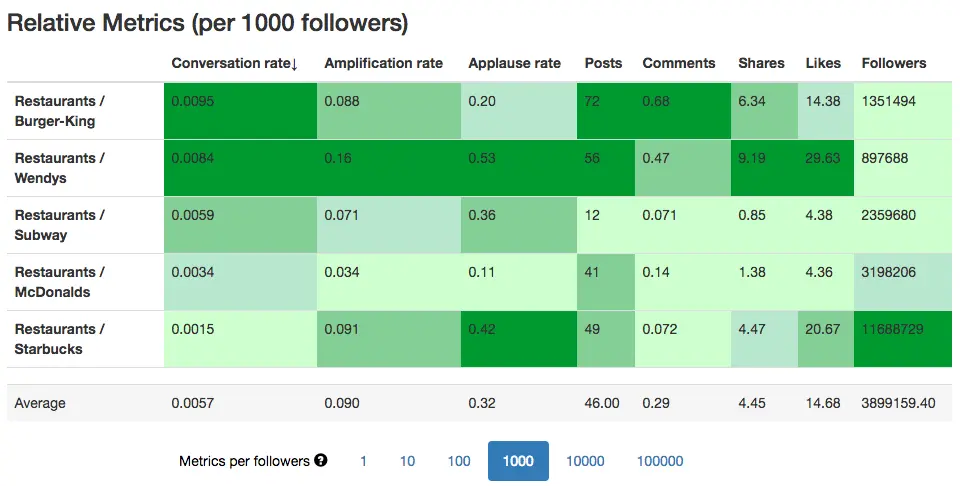Just a quick glance at this report and you know what’s happening in your landscape. The darkest colors lead the way - the highest values for each metric is marked dark green.
Sort the table and find the leader in your landscape by each social interaction, metric or Number of Followers.
Let’s imagine that you are running a fast food restaurant chain and want to spy on your Twitter competition:

Starbucks has the biggest audience on Twitter and surprisingly, the highest level of engagement on all three types of social interaction. Congrats to Starbucks! And look at Burger King; they have 2 times more tweets than Starbucks, yet so much less engagement and followers.
Looks like the key to success isn’t posting more, but tweeting interesting content at the right time in the right amount. So go find out your ideal Posting Density and sweet spot for Posting Time, than get rid of un-engaging content.
Don’t forget to look at the Relative Metrics Leaderboard as well. All the pages have a different Number of Followers, so it would be unfair to compare their engagement without considering how big their audience is:

(By default, these metrics are divided by 1000 Followers, but you can select a different scale from the switcher below the table).
Why are relative numbers so important? Well, if you have 150 likes per post and 1000 followers - that’s great! The same data divided into 100,000 fans is not that great. That’s why it can put you on to the fact that your followers don’t like you as much as you thought.
Amplification rate - indicates how many times on average each of your posts was Shared/Retweeted (e.g. Amplification rate = 5 means that each of your posts was shared 5 times on average).
Amplification rate = # of Shares/ # of Posts
Conversation rate indicates how many Comments/Replies on average each of your posts has received (e.g. Conversation rate = 5 means each of your posts has an average of 5 comments).
Conversation rate = # of Comments/ # of Posts
Applause rate - indicates how many Likes/Likes each of your posts has received on average (e.g. Applause rate = 5 means each of your posts has an average of 5 Likes).
Applause rate = # of Likes/ # of Posts
Relative Amplification rate - indicates how many times on average each of your posts was Shared/Retweeted per 1000 Followers (e.g. Relative Amplification rate per 1000 Followers = 1 means that out of 1000 Followers, your post was shared on average 1 time).
Relative Amplification rate = # of Shares / # of Posts / # of Fans * 1000
Relative Conversation rate - indicates how many times on average each of your posts was Commented on by 1000 Followers (e.g. Relative Conversation rate per 1000 Followers = 2 means that out of 1000 Followers, your posts receive an average of 2 comments per post).
Relative Conversation rate = # of Comments/ # of Posts / # of Fans * 1000
Relative Applause rate - indicates how many times on average each of your posts was Liked by 1000 Followers (e.g. Relative Applause rate per 1000 Followers = 3 means that out of 1000 Followers, your posts receive an average of 3 likes per post).
Relative Applause rate = # of Likes / # of Posts / # of Fans * 1000